Author Archive
« Older EntriesNewer Entries »
Kitchissippi Times plugs “Now That I’m Here”
Thursday, September 15th, 2016—NewsThank you to writer Bhavana Gopinath for the Kitchissippi Times piece on my latest Wonderpress children’s book, Now That I’m Here, which comes out September 18, 2016.
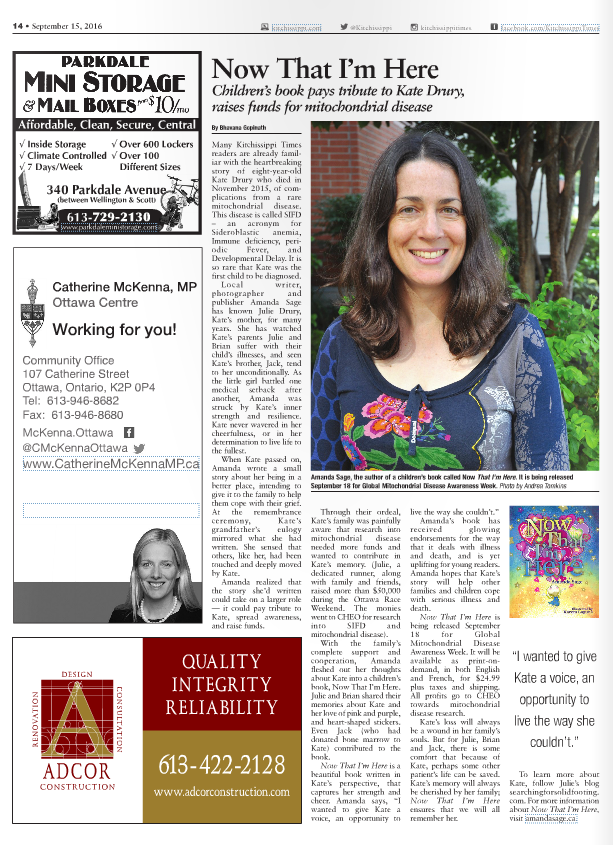
Ottawa Citizen covers “Now That I’m Here”
Tuesday, September 6th, 2016—NewsThanks to the Ottawa Citizen and writer/photographer Bruce Deachman for the great piece on my new children’s book, Now That I’m Here. The book will be available to order via print-on-demand as of September 18, in English and French, with profits going to the CHEO Research Institute.
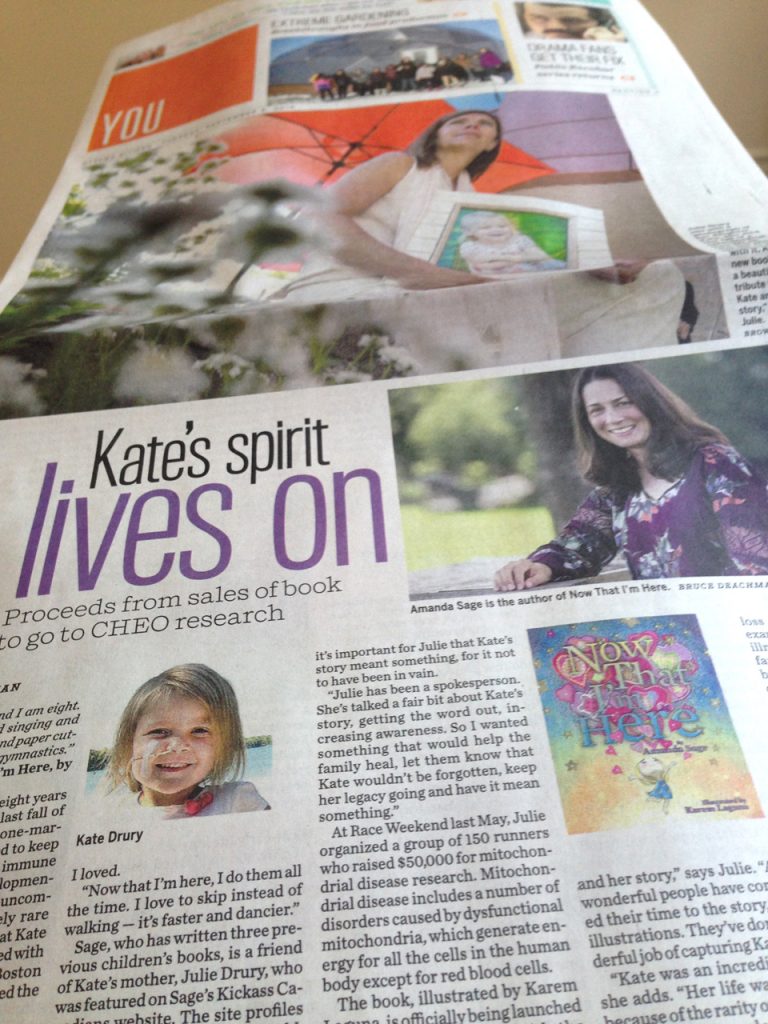
The Babadook
Wednesday, August 24th, 2016—FilmThe Babadook (Australia/Canada 2014, Horror), Writer/Director: Jennifer Kent
I took my time getting to The Babadook, but this one is definitely a case of “better late than never.”
Horror is a genre I tend to avoid. I hate gratuitous violence and don’t like being scared just for the hell of it. The Babadook is horror I can handle; instead of cutting up bodies, it dissects psyches.
Specifically, the film looks at the strained relationship between widowed mother Amelia (played beautifully by Essie Davis) and her son, Samuel (Noah Wiseman). Amelia’s husband died in a car accident while driving her to the hospital for Samuel’s birth. Six years later, she still can’t bear to celebrate Samuel’s birthday on its proper day.
Things are strained in Amelia’s household to begin with. Both she and Samuel are troubled sleepers plagued by nightmares. Amelia dreams about her husband’s accident. But Samuel is haunted by a faceless monster. He can’t put a name to it; he just knows it’s there.
Every night, Samuel and his mother go through the ritual of inspecting his closet, peering beneath under his bed. And during the day, he practises magic tricks and fires off homemade weapons: “I’ll kill the monster when it comes, I’ll smash its head in!”
It’s all an attempt to protect himself and his mother from whatever darkness is descending, but it only adds to the mounting pressure on Amelia. Samuel is unruly, uncontrollable. He gets expelled from elementary school for endangering other children. His manic energy and incessant calls of “Mommm! Mahmmmmmmm!!!!” wear on her nerves, already fraught from chronic sleep deprivation. She’s quick to snap, even when he simply hugs her too hard.
And then we meet Mister Babadook. “If it’s in a word or in a look, you can’t get rid of the Babadook.” Samuel finds him in an authorless pop-up book his mother hasn’t seen before; it’s been sitting on the shelf, out of sight, perhaps not out of mind.
The book is a brilliant way of introducing the film’s demon—a dark man in a top hat and black cloak who kills children in their beds. With its chilling yet artful illustrations and eerie, poetic writing, Mister Babadook creeps into the viewer’s psyche just as much it does Amelia’s and Samuel’s.
“You start to change when I get in, the Babadook growing right under your skin.”
Amelia quickly puts an end to the story, but it’s too late; Samuel knows what’s coming. As his obsession with building weapons grows, so does Amelia’s anger and frustration with her son. She insists that the monster isn’t real, but he’s certain that it’s only getting closer.
He isn’t wrong. The question is: Where does the Babadook truly reside? In their closets, cupboards and basement? In Amelia’s mind? Maybe in both.
That, to me, is the most intriguing part of the movie—its exploration of fantasy and reality, sanity and delusion. It reminded me a bit of Take Shelter, in how it asks the audience to decide, at least for a time, whether the threat is real or imagined, and in how it throws light (and shadow) on mental illness.
The Babadook isn’t afraid to show us something really scary, and its impact is profound and disturbing. In place of cheap thrills and gore, it uses imaginative, often abstract visuals. The film does a lot with its soundscape, too; whenever the Babadook stirs, we hear a chilling mix of repetitive sounds that are almost familiar, almost identifiable, like crickets at night or the electrical buzz of an unstable light bulb about to burn out.
Amelia tries to silence the noises by destroying the book, but the more drastic her attempts to bury it, the more fiercely it returns. “The more you deny me, the stronger I get.”
The Babadook becomes a metaphor for Amelia’s grief and depression. She’s stuck in the moment of her husband’s death, unable to process her emotions. She’s also suffocated by the guilt of blaming Samuel and the unease of her son standing in as her only companion.
Their relationship never crosses any sexual lines, but there’s a tangible discomfort from Amelia. At one point, Samuel bursts in on her in the night, interrupting an intimate moment while she’s alone in bed (there’s that electrical buzzing sound again…), and it highlights the strangeness of their dynamic—how Samuel’s birth brought about her husband’s death, effectively replacing one with the other.
As the world grows ever darker for Amelia and Samuel, we’re forced to wonder exactly what’s true. Amelia is being driven into psychosis through depression and sleep deprivation. And yet there he is, Mister Babadook—lurking in corners, scuttling and spattering across the ceiling like an insect or an inkblot, morphing, indeterminate, a Rorschach test. What is he? What is it? What does it mean to Amelia? What does it mean to us? And which demon would be harder to exorcise: the supernatural or the psychological?
The Babadook shows us that we don’t always have to eradicate our demons. Sometimes it’s enough to be aware of their presence and learn how to manage them. Because sometimes these things—in the shadows, in the mind—never really go away.
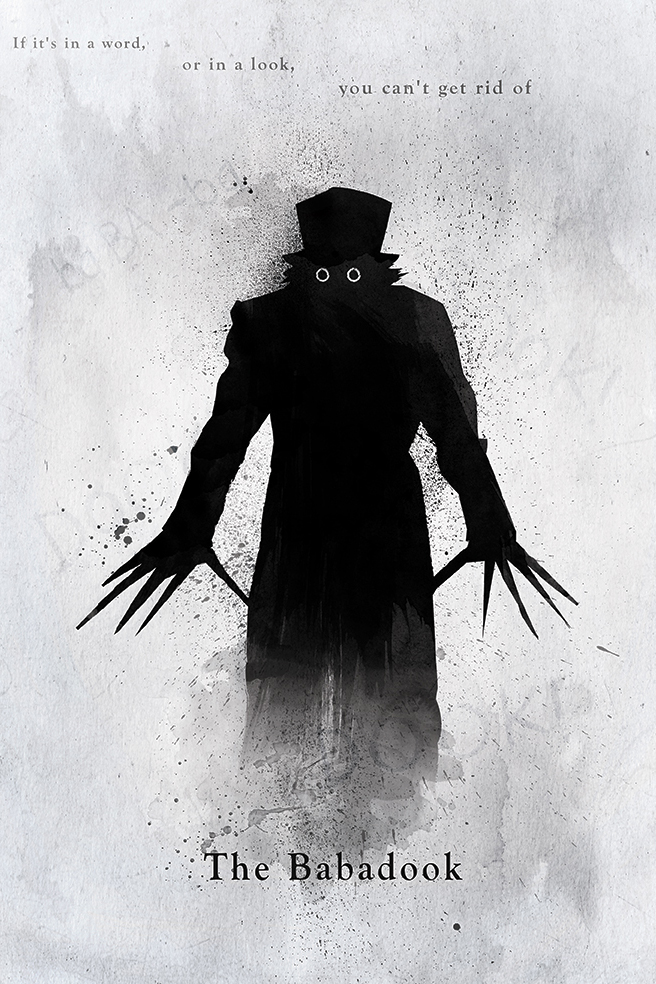
Chris Hadfield endorses “Now That I’m Here”
Sunday, May 1st, 2016—NewsAstronaut and overall extraordinary human being (and Kickass Canadian!) Chris Hadfield has endorsed my upcoming children’s book, Now That I’m Here:
“Now That I’m Here is a touching, helpful book for all of us who deal with illness growing up. A lovely, sad, good and loving tribute that gives hope and strength where it’s needed most.”
Thank you so much, Chris!
Published through my shingle, Wonderpress, Now That I’m Here is a tribute to young Kate Drury and will raise funds for the CHEO Research Institute in support of research into SIFD, the type of mitochondrial disease she suffered from. It will be available for print-on-demand orders, in English and French, this September 2016, in time for Global Mitochondrial Disease Awareness Week.
Here’s a look at one of the illustrations in progress, by the gifted Karem Laguna:

You can learn more here. For the latest updates, please ‘Like’ the Now That I’m Here Facebook page.
Sleeping Giant
Saturday, April 30th, 2016—FilmSleeping Giant (Canada 2015, Adventure/Drama), Writers: Andrew Cividino, Blain Watters, Aaron Yeger; Director: Andrew Cividino
When the credits rolled on Sleeping Giant last night, the audience was completely silent for a beat or two, before erupting into applause. That’s the impact this movie has. It’s raw, real and chilling, and it gets into your head—and heart—in a way that few films do.
Sleeping Giant is adapted from writer/director Andrew Cividino’s 2014 short film of the same name. Set in Thunder Bay, Ontario, the movie spends a few summer weeks hanging out with Adam (Jackson Martin), Riley (Reece Moffett) and Nate (Nick Serino), three teens cottaging with their families on the shores of Lake Superior, near the majestic Sleeping Giant Provincial Park.
Adam stays with his well-to-do parents in their spacious abode. Riley and Nate, cousins, crash at a much smaller pad belonging to Nate’s grandma (Rita Serino). The three boys’ disparate backgrounds go beyond socioeconomics. Adam is nurtured and sheltered, for better and for worse; he’s more reserved, better mannered. Riley and Nate, on the other hand, talk rough and play rough. They’re destructive and violent with their actions and their words—especially Nate, who constantly makes a show of being stronger, raunchier and more experienced than the others.
Sleeping Giant has a few twists to its story, involving Adam’s less-than-honourable father (David Disher), and his friend Taylor (Katelyn McKerracher), an attractive teen girl who becomes a point of contention between him and Riley. But it’s mainly a summer coming-of-age story, with the three boys standing atop a pivotal cliff, deciding which way to jump—what kind of adults they will become.
A lot of this film is terrifying to watch. Seeing the trouble the boys get into, being privy to their often volatile thought processes, realizing how malleable they are; it’s a sobering reminder of the past, of how wrong things could have gone, and of what could happen in the future, what’s going on right now. It also makes me grateful for the grounded, responsible teens in my own life. Because in Sleeping Giant, things take a dive for the worse.
Walking into the theatre last night, the title of The Weeknd’s album Beauty Behind the Madness came to mind. The film does venture into that territory, or perhaps also the madness behind the beauty. These boys have potential; even Nate shows glimpses of good qualities, like intelligence and honesty, and of wanting to do more with himself. They’re at such a delicate age, each one wrestling with their own sleeping giant—id vs. ego, and the submerged darkness that threatens to take over when their burgeoning identities are threatened.
Adam, Riley and Nate don’t really know who they are yet. The film even suggests, tacitly, that Adam may be questioning his sexuality, with its lingering shots of Adam and Riley tussling, or Adam’s lingering gaze that often favours Riley over Taylor.
Watching Sleeping Giant, it was hard not to reflect on my own coming-of-age movie, Sight Lines, a short that was shot in the summer of 2002 around 1000 Islands in Gananoque, Ontario. Not to suggest that my movie is on par with Cividino’s, but it shares many elements with Sleeping Giant, from 13-year-old Fletcher’s (David Coomber) false bravado about drugs and sexual experience, and his destructive tendencies (both idle and pointed), to the cliff-jumping scene.
There are certain shared experiences about being a young teen in Canada, and about cottage living, that Cividino really captures in Sleeping Giant, making the film easy to relate to.
A large part of the credit for this goes to the extraordinary performances from the three leads. Moffett and Serino are real-life cousins, reprising their roles from the short version of Sleeping Giant. They have no prior acting experience, and perhaps because of that, achieve very real, seemingly improvised delivery. (In fact, much of the cast features non-actors or first-time actors, including Moffett and Serino’s actual grandmother as Nate’s grandma, to good effect.) Martin, who had already wet his feet in the acting world, still arrives at the same nuance and intense realism, bringing incredible subtly to Adam as he experiments with the boundaries of honesty and manipulation, compassion and cruelty.
It’s hard not to notice the contrast between the youth’s naturalistic performances and the stilted delivery from some of the adult actors, most notably Disher (ironically, the most experienced of the performers). Adam’s dad is a real dick, to use the kids’ lingo. He comments on Taylor being “new and improved” and advises 15-year-old Adam to “tap that” while the opportunity is still available. He also makes lame attempts to appear cool in front of Adam’s friends. So I wondered at times if Cividino directed Disher to deliver the awkward performance he does, to make him even less relatable or likeable.
I don’t know about that. But whatever the case, Disher’s relatively weak performance is one of the few detractions from an otherwise successful film.
From the opening sequence that surveys Sleeping Giant Provincial Park to the tune of Bruce Peninsula’s pulsing, foreboding score, to a perfect final moment that says everything without uttering a word—the ending that left the audience speechless—Sleeping Giant is imposing, impressive and important, as a work of art and a reflection of humanity.
For more insights into the film and how it was made, check out Cinemablographer’s recent interview with Cividino.
* * *
This post is dedicated to MJP, who introduced me to Thunder Bay and who works hard to help youth navigate the perils of their own sleeping giants.

Zootopia (feat. David Walberg)
Thursday, April 7th, 2016—FilmZootopia (USA 2016, Animation/Action/Adventure), Writers: Jared Bush, Phil Johnston; Directors: Byron Howard, Rich Moore, Jared Bush
It’s not often I get to review a movie with one of my three nephews after having watched it together. They’re not from around here, so when we do team up, we all watch the movies separately and then have a chat.
So far, all three boys (Jon, Isaac and David) helped out with The Lego Movie, Jon and I covered The Hunger Games, and he and Isaac both joined me for The Hunger Games: Catching Fire, The Hunger Games: Mockingjay Parts 1 & 2 and Divergent.
This Zootopia review is extra-special to me because I got to take my youngest nephew, eight-year-old David, to see the Disney animated movie while he was visiting. Oh yeah, and also because it steals I mean shares the title of the book I wrote for David in 2010 through my publishing shingle, Wonderpress. (I wasn’t playing favourites; I also wrote Dinostory for Jon and Astrorocket for Isaac.)
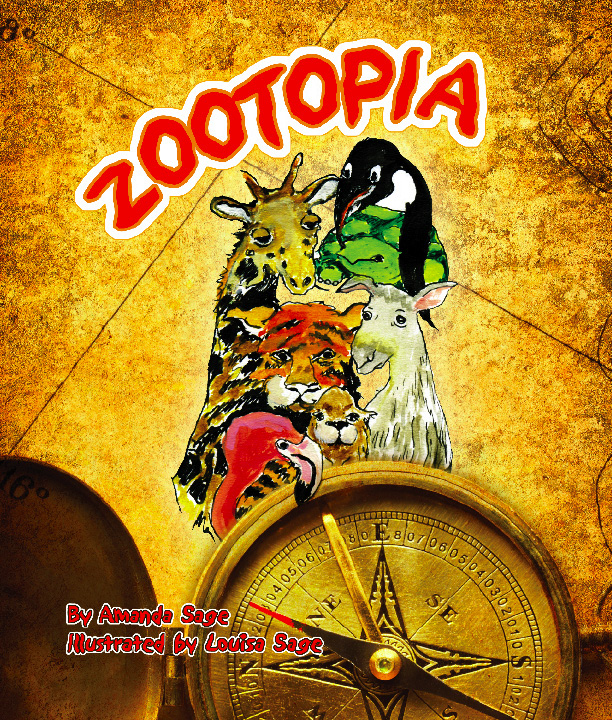
We both really enjoyed Zootopia (the movie—though we’re partial to the book, too). Here’s the scene: It’s thousands of years since mammal predators and prey had any trouble co-existing, and a keen young bunny named Judy Hopps (Ginnifer Goodwin) is determined to make her mark in a world where “anyone can be anything.”
Judy bounds out of her hometown, Bunnyburrow, to become the very first bunny cop at the Zootopia Police Department (ZPD). Officer Hopps takes her place alongside a menagerie of other animals, including a buffalo (Chief Bogo, perfectly voiced by Idris Elba), a rhino (Officer McHorn) and a donut-gulping cheetah (Officer Clawhauser, voiced by Nate Torrence). Judy’s relatively small stature doesn’t bode well for her career prospects; while everyone else gets juicy assignments, she’s stuck with parking ticket duty.
Judy tackles her role as meter maid with the same zeal that led her out of the carrot patch and into the sprawling mammal metropolis of Zootopia. But it isn’t long before she scrambles her way onto the city’s biggest case: the 14 missing mammals—all predators. Judy enlists the assistance of Nick Wilde (Jason Bateman), a wily fox and even wilier con artist she’s able to hustle into helping her.
What follows is an interesting examination of the dangers of judging animals by their species, holding pre-conceived notions about others, and prescribing expectations.
When Judy and Nick discover that the missing predators have all gone savage, Zootopia is thrown into unrest, with prey casting sidelong glances at predators. Not that everything was idyllic before the savagery; Judy never reports to work without her can of fox spray, a holdover from her parents’ mistrust of foxes and a frightening encounter from her childhood.
Zootopia’s premise is smart, timely and delivered in a very well wrapped package: Bright, bold animations with meticulous attention to detail (David especially liked the way they moved); a tight, witty, highly polished script; and an inventive world in which the animals can roam and romp.
Zootopia consists of a range of ecologically diverse districts, like Sahara Square, Tundratown and Rainforest District. Little Rodentia was especially charming, with its many roadways and overpasses made of clear plastic hamster tubes. “I liked the rodent town,” says David. “There were lots of gerbils!”
The city is built to accommodate all types of mammals. Elephants are served massive (relative to us) ice cream cones served up (somewhat) fresh by the trunkful. Mice scurry through miniature gateways and get dolled up at small-scale (but high-class) hair salons.
“I liked it when the guinea pigs chomped on the Pawpsicles,” says David. So did I; the several-tiny-bites-sized frozen treats are made in molds formed by Chihuahua footprints in the snow.
Zootopia is a playful, inventive place for Judy and Nick to guide us through a study in race (or in this case, species) relations. The messages are clear, but they extend beyond the obvious ‘Don’t judge a book by its cover’ adage. For example: Be careful what you tell people about themselves; they just might believe it.
The movie does a good job of challenging assumptions, both personal and structural. “It messed around with your expectations,” says David, pointing out a few instances when the story took surprising turns.
I asked him if he thinks all animals—predators and prey—really could get along. “Well, it depends,” says David. “They could get along if they weren’t so smart-mouthed. Like the fox, Nick, you have to admit he was pretty smart-mouthed. But he’s also quick-witted. It’s good to have someone quick-witted around. Or you could just memorize Shakespearean insults like I do. ‘Go to hell for an eternal moment or so.’ That’s from The Merry Wives of Windsor.”
(He actually said that. What a kid.)
David talked a bit more about the film’s central message, and he said something very wise: “No animal really is just one thing. Prey can also be predators—especially humans.”
He’s right. Almost all of us can attack or be attacked.
For an animated children’s film, Zootopia brings a lot to the conversation. As great as it is, though, I thought it missed a couple good opportunities for commentary.
Assistant Mayor Bellwether (Jenny Slate), who is a sheep, remarks that Zootopia is comprised of 90% prey. I expected the movie to draw a parallel to the 99%, with most of the prey being smaller and more vulnerable than the predators. But it didn’t.
Then there was the highly sexualized Gazelle (Shakira), Zootopia’s mammal pop star. We see enough of scantily clad females in everyday media, put in a position where they’re expected to trade in on their bodies for success or recognition; it would have been nice if Disney hadn’t felt the need to ensnare the film’s only icon in a sequined miniskirt and crop top.
I really did like Zootopia, but for a movie so determined to do away with stereotypes, it sure has its share of them. Like the wolves who can’t keep themselves from chiming in once the first howl is released. And the sloths who move at a, well, sloth’s pace.
Mind you, caricaturing sloths leads to a priceless scene at the Department of Mammal Vehicles (DMV) when Judy and Nick drop in to pursue a lead. So, I’m not complaining—just observing.
“The sloths at the DMV were pretty funny,” says David. “It was a good joke.”
In fact, that’s where we first meet David’s favourite character in the movie, Flash the sloth (voiced by Raymond S. Persi).
Zootopia has loads of fun anthropomorphizing the animals, shrewdly reflecting human culture and convention. Judy drew chuckles from the audience when she explains to Officer Clawhauser: “You probably didn’t know, but a bunny can call another bunny cute, but when other animals do it, it’s a little…” Her mortification at seeing animals do yoga naked is also pretty awesome. Or, as David says, “AWKWARD!!!”
After the movie, I asked David whether he’d rather be predator or prey. “Prey. I’d be an elephant. No—a panda. Or a koala.” So, it doesn’t matter if you’re big or small? “Depends who I’m up against. The big ones are more out of control, like I am. That’s a joke.”
David and I both highly recommend this smart-mouthed, fun-loving foray into the animal world. Overall, it’s creative, delightful and clever, and it presents us human animals with some important things to consider.
Oh, and I loved seeing ZTV newscaster Peter Moosebridge, voiced by CBC’s Peter Mansbridge.
And you can buy my version of Zootopia—the children’s book—here.
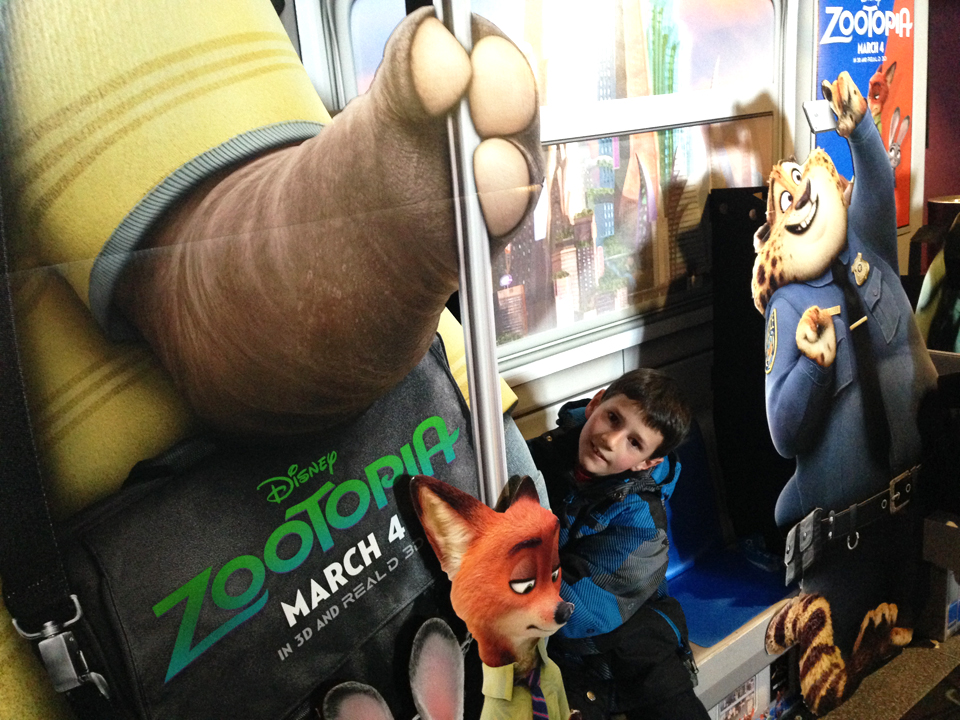
David aboard the “Zootopia” express
New Wonderpress children’s book in the works
Saturday, April 2nd, 2016—NewsThrough my publishing shingle, Wonderpress, I’m working on a new children’s book called Now That I’m Here. I wrote it as a tribute to a young girl from Ottawa name Kate Drury, who passed away last year from mitochondrial disease. The book will be available for print-on-demand orders, in English and French, this September 2016, in time for Global Mitochondrial Disease Awareness Week. All profits will go to the Children’s Hospital of Eastern Ontario Research Institute.
You can learn more here. For the latest updates, please ‘Like’ the Now That I’m Here Facebook page.
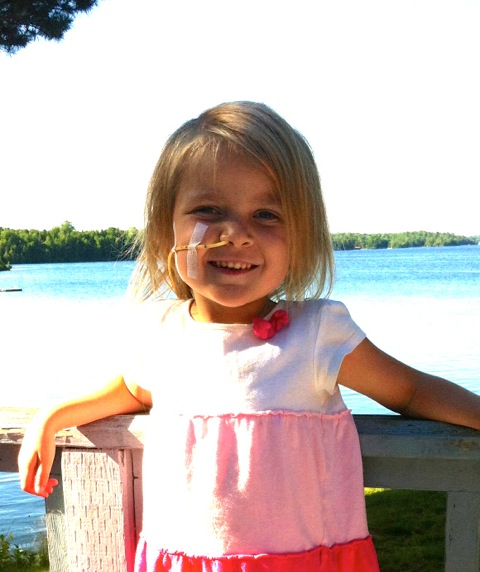
Blackbird (live) & The Crucible (live)
Monday, March 28th, 2016—FilmBlackbird (Belasco Theatre, 2016), Writer: David Harrower; Director: Joe Mantello
The Crucible (Walter Kerr Theatre, 2016), Writer: Arthur Miller; Director: Ivo van Hove
I do not know which to prefer,
The beauty of inflections
Or the beauty of innuendoes,
The blackbird whistling
Or just after.
I read these words on a plaque, embedded in the sidewalk, shortly after arriving in Manhattan last week. The plaque is one of several lining the way to the New York Public Library on 5th Avenue, but it was this quote, from Wallace Stevens’ poem Thirteen Ways of Looking at a Blackbird, that spoke to me. GB and I had tickets to see Blackbird on Broadway, starring Jeff Daniels and Michelle Williams, at the end of our visit and knew it would be one of the trip’s highlights. So, seeing the plaque felt like a fitting welcome to the city.
What I didn’t know then, reading those words, was that the trip would be bookended by a bonus highlight. There was another Broadway show I’d really wanted to see—The Crucible, featuring an extraordinary cast that includes Saoirse Ronan, Ben Whishaw, Sophie Okonedo and Ciarán Hinds. Tickets were pretty pricey, so we initially passed on that play. But while wandering through Central Park that first night in New York, we decided, on a whim, to see if we could get rush tickets.
What we got was so much better than I imagined. We were offered an incredible discount on prime seats: centre orchestra, just a few rows back from the stage, and right beside Sean Penn. It may seem like a silly thing to mention here, but being next to one of the greatest living actors, and someone whose work and films I greatly admire, couldn’t help but amplify the experience of watching such a high caliber cast performing in such an incredible production.
To me, one of the very best things about New York is that it provides a stage for the highest concentration of the world’s most exceptional artists. In Manhattan, on any given day, you have access to performances you just wouldn’t see anywhere else. And this isn’t only on Broadway. While wandering through lower town, we saw a poster for an upcoming talk at a community centre; the speaker was David Mamet. When I lived in New York several years ago, I joined some friends at the last minute for a panel and Q&A at the Irish Arts Center with Gabriel Byrne, Helen Mirren, Tim Robbins and Susan Sarandon. There’s always something going on and I find it exhilarating.
So, as we waited for the curtain to rise in the Walter Kerr Theatre, sitting next to Sean Penn, who is easily one of my favourite actors, the point came across loud and clear: Magic happens in New York City, and we happened to be catching an act that evening.
Regardless of your seatmate, The Crucible is an experience worth having. It’s directed by Ivo van Hove, the theatre legend who delivered a highly praised production of Arthur Miller’s A View From the Bridge on Broadway late last year. Set during the Salem witch trials of the late 1600s, The Crucible was written in the 1950s as a parable about McCarthyism, but it continues to be eerily prophetic, especially in the face of today’s escalating xenophobia and religious discrimination.
John Proctor (Whishaw), the well-meaning husband of Elizabeth Proctor (Okonedo), tests the limits of the old “hell hath no fury” adage when he tries to move past his indiscretion with young Abigail Williams (Ronan). The Proctors former servant, Abigail also dabbles in witchcraft. When the townsfolk suspect her and her friends of ill doing after a few mysterious deaths and some late-night incantations in the woods—in the buff—they turn around to point their fingers at others, including the Proctors. From there, things quickly spiral down the rabbit hole.
The Crucible’s set is spare yet detailed, and dimly lit—glowing candles here, a fiery stovetop there. Among other pieces, it features an ever-present chalkboard in the background, where characters occasionally write commandments or proclamations as the audience is schooled in the dark arts of humanity: judgment, fear, dishonesty, blame.
The play’s music, by celebrated stage and screen composer Philip Glass (The Hours, Fantastic Four), feels almost ambient. It pulses throughout much of the production, sometimes with strings, others with percussion, mostly subdued but nearly always present.
The Crucible’s biggest success comes in the form of its large and highly skilled cast, delivering fine performances all around. It was a privilege to see Ronan (Atonement, The Lovely Bones), a gifted film actor, perform live. It was even more breathtaking to watch Whishaw (The Danish Girl; Q from Skyfall and Spectre) and especially Okonedo (Hotel Rwanda) onstage. They deliver commanding, riveting performances that literally left me shaking after the curtain call.
As good as The Crucible is, Blackbird’s tune is the one that still echoes through my thoughts.
From the moment the play opens, we know that Blackbird is a story about people laid to waste. When the set, a drab meeting room in a bleak office, spins around on a turntable, finally facing us, we see that it’s littered with garbage. The trash bin is overflowing, the table carelessly scattered with leftovers and other remnants. The place is filled with the ruins of exchanges and conversations past; it was abandoned and no one took the time to clean things up.
Into this room, Ray (Daniels)—or Peter, as he’s now known—forcibly marches Una (Williams). Tension is everywhere, beating through their bodies, blasting forth with every word, and it doesn’t let up for the next 90 minutes.
Through Una’s broken words and Ray’s defensive bluster, we soon learn that the pair was sexually involved 15 years ago, when he was 40 and she was only 12. They haven’t seen each other since the fateful night that separated them, when Una was stranded in a suite and Ray was charged for his crime.
Neither has recovered from their three-month affair, though both have tried (and been tried). After serving his sentence, Ray changed his name, found a new job and partner. Una, in desperate bids for both escape and control, pursued a long line of sexual partners, angrily shocking her parents with the details; based on her steady sniffle and erratic body language, she also chased down a few other lines.
I saw Blackbird from a very different vantage point than I did The Crucible. I was perched at the front of the Belasco Theatre’s third-level balcony, looking almost straight down at the stage. It made for a slightly dizzying experience that added to the play’s sense of unease.
Watching Una and Ray, two lost souls crippled by love, anger, shame and betrayal, frantically trying to wrench themselves free of the pain, is an intense experience. Although there’s no denying how wrong their involvement was, Ray and Una did love each other; perhaps they still do. But in the aftermath, the only way they found to move forward was in darkness.
Ray’s life, as Peter, is a lie.
And Una. Una lived through public and private humiliation. Painted as both a temptress (with “suspiciously adult yearnings”) and a victim, she was repeatedly told that the love she thought Ray had for her was driven only by the sick desires of a dangerous and calculating predator. For nearly two decades, she was left to relive Ray’s final words to her, their final moments together, over and over, like a sleepless child lying in bed after the lights have gone out, with no one to talk to, no one to comfort her. Nothing there but memory and imaginings, both so easily distorted.
Daniels delivers a strong, solid performance. But Williams blew me away. She has been wonderful so many times before (Blue Valentine, Take This Waltz). As Una, she transforms herself. Her body is electric, her movements frenetic. I didn’t recognize her voice; at times, she practically growls rather than speaks.
I wish I could see Blackbird again, from another perspective, to get another glimpse—a closer view, but also just a different view, to see how the actors play the story out on another night, how they might change the key for the often-lyrical dialogue they deliver.
There’s very little music in Blackbird; I recall only a few strains coming through to punctuate certain moments. But after the actors leave the stage, once the damage is done, we’re left with the most perfect song—9 Crimes by Damien Rice:
Leave me out with the waste
This is not what I do
It’s the wrong kind of place
To be thinking of you…
It’s a small crime
And I’ve got no excuse…
Is that alright?
Is that alright?
Is that alright with you?
No.
After seeing Blackbird, on the way back to our hotel, we walked again down Library Way, revisiting the plaque I’d seen on our first night. There, on a misty, mystical night—our last in New York—I read Stevens’ emblazoned words once more. This time, revelling in the remembering of such a powerful play, the words echoed even louder:
I do not know which to prefer…
The blackbird whistling
Or just after.
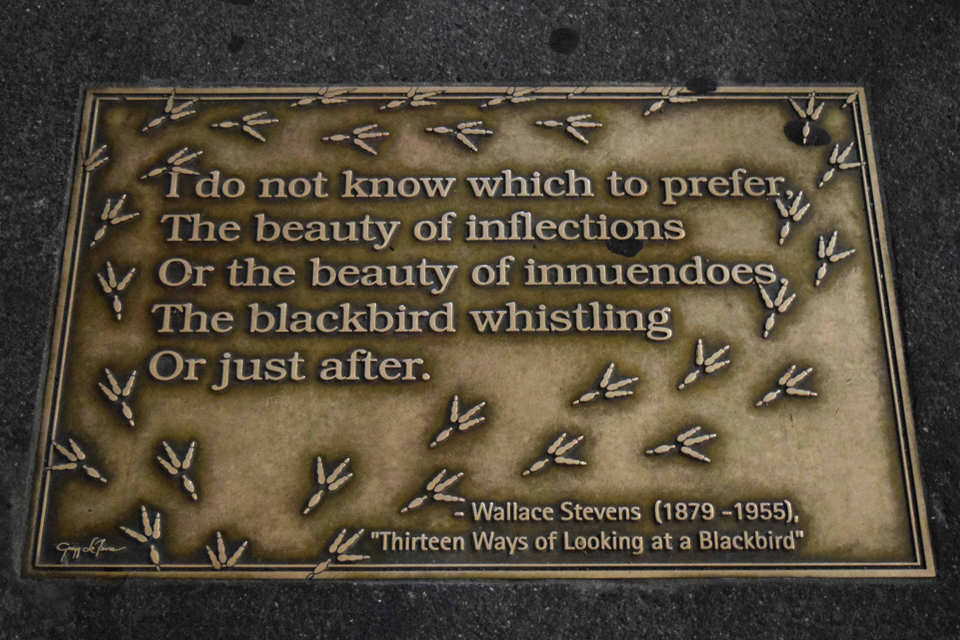
* * *
The Crucible is currently in previews; it opens March 31, 2016 and runs until July 17. Blackbird runs until June 11. I hope you have the opportunity to see both.
“The Jenn Report” features Kickass Canadians
Thursday, February 11th, 2016—NewsBig THANKS to Jennifer Hazen for featuring me and Kickass Canadians on The Jenn Report!

The Hunger Games: Mockingjay Parts 1 & 2 (feat. Isaac and Jonathan Walberg)
Monday, December 14th, 2015—FilmThe Hunger Games: Mockingjay Parts 1 & 2 (USA 2014/2015, Adventure/Sci-Fi), Writers: Peter Craig, Danny Strong; Director: Francis Lawrence
[Spoiler Alert: This is a joint review of Parts 1 and 2 of The Hunger Games: Mockingjay. I don’t give away any key plot points from the second part, but I do reveal what happens at the end of the first. Proceed with caution!]
Here we are, back for the final installment of The Hunger Games reviews with my nephews.
If you’ve been following this blog, you’ll know I started reviewing the series, based on the books by Suzanne Collins, at the suggestion of my eldest nephew, Jon (now 13). We jointly reviewed The Hunger Games, and my second nephew, Isaac (now 12), joined us in reviewing The Hunger Games: Catching Fire.
Now all three of us are back for the third and final review, a joint write-up of Parts 1 and 2 of The Hunger Games: Mockingjay.
To recap, The Hunger Games films are set in a future world where the wealthy rule from the Capitol and the rest live in varying states of squalor and unrest, in Districts 1 through 13. For three quarters of a century, two children from each district have been offered up each year as tributes to fight to the death in a televised reminder of the Capitol’s power—and fury.
The first two films show Katniss Everdeen (Jennifer Lawrence) and Peeta Mellark (Josh Hutcherson) competing in the 74th and 75th Hunger Games, on behalf of their District 12. Having emerged as victors the first time around, their “reward” is to face off against the victors from games past for the Quarter Quell. But things don’t go as planned for the Gamemakers, and Katniss is rescued from the 75th Games by rebels and transported to District 13.
This is where Mockingjay picks up. Katniss, still in the throes of post-traumatic stress disorder, is being persuaded by President Alma Coin (the always wonderful Julianne Moore) and former Head Gamemaker Plutarch Heavensbee (the equally wonderful, and tragically departed, Philip Seymour Hoffman) to rally the rebels and wage war against the Capitol.
While Katniss was retrieved from the 75th Hunger Games arena, Peeta was captured by the Capitol, who torture him, hijack him (a form of drug-induced brainwashing) and deploy him as a device to turn the districts against Katniss. He’s rescued at the end of Mockingjay: Part 1, but spends Part 2 grappling with his misguided hatred for Katniss and his compulsion to kill her, thanks to the Capitol’s programming.
Heavy stuff for a teen romance. But seriously, while there is a love triangle between Peeta, Katniss and her childhood friend Gale Hawthorne (Liam Hemsworth), who joins her in the fight against the Capitol, the filmmakers are right not to give the romantic storyline more weight than is due.
Katniss comes close to unraveling under the pressures she faces. Her life, and those of her loved ones, is almost constantly in jeopardy. If that weren’t far more than enough, she’s forced to quickly learn hard truths about her world and everyone in it. At a phase when most people take many years to figure things out, adolescent Katniss has to make sense of it all at warp speed, and under life-or-death circumstances. It’s a complex psychological task, and one that would certainly overshadow the pressure to choose a boyfriend.
“I thought it was good that Mockingjay didn’t focus too much on the relationships,” says Isaac. “The movies are about the districts trying to take over the Capitol.”
While the first two films focus on the Hunger Games themselves, Mockingjay’s two-parter is “more about the politics and strategy, more about the rebels’ insurgency against the leading government,” says Jon.
It’s less about the games than it is about refusing to play them anymore. Not that the Capitol’s President Snow (Donald Sutherland) doesn’t try to keep throwing the protagonists into the arena, especially as they hit closer and closer to home.
So, given that the series is called The Hunger Games, do the Mockingjay installments stand alone as films? Or do they require some background reading and viewing?
“They were good, I thought they related well to the book,” says Jon, who is both literary and very literal. “But if you want to see the actual plot of the Hunger Games, I recommend watching the first two movies before seeing Mockingjay.”
“You wouldn’t really get the Hunger Games part if you just saw the two Mockingjay films,” says Isaac. “But they’re still good movies overall, even if you haven’t read the series or seen the first two movies.”
Jon recently started a politics section in his junior high school’s paper. Given his interests, I asked how he thought the films relate to real-world events and what lessons we can glean from them.
“It focused on the rebels against the government in power, so it could reflect a lot of what’s happening in Syria,” he says. “I think that if (something like the Hunger Games) were to happen in the future, that a rebellion would happen faster than (the 75 years it took) in the book and the movie.”
As far as lessons learned, Jon has some very wise words: “The districts themselves should have some power. The power shouldn’t all be with the Capitol.”
Before seeing Mockingjay: Part 2, I’d been wondering how the film adaptation would handle the ending. Mockingjay the book ends with some powerful, poetic words. I knew they wouldn’t cut them. But the words are written in Katniss’ voice, as the narrator, and also I knew the films, which never use narration, wouldn’t resort to it in the last moments of the final installment.
I’ll let you see for yourself how the filmmakers dealt with the challenge. But I did want to see what Jon thought of it. “I liked how they handled the final words,” he says. “It would have been different if they’d done narration. But overall I didn’t like the ending. But I’m the worst person to ask about endings; I, for one, generally hate the endings of all final movies and books in a series because I just hate the fact that they have to end.”
I love that.
As for Isaac, even though the Mockingjay installments don’t deal as much with the actual games as the first two films, the two-parter is still “a good continuation of the series and a good conclusion,” he says.
If The Hunger Games movies do have to end, they do it well. Director Francis Lawrence, who stepped in after the first film, does a solid job bringing Mockingjay to the screen. “The action was pretty good,” says Isaac. “They had good special effects for the booby traps (when the rebels invade the Capitol) and the weapons and stuff like that.”
The Mockingjay films also draw some fantastic performances from the actors. As Katniss, Jennifer Lawrence leads the way; she more than rises to the task of making her complicated character believable—and heart wrenching.
In addition to Hoffman, Moore and Sutherland, standouts from the impressive supporting cast include: Elizabeth Banks as former tribute escort Effie Trinket; Woody Harrelson as past District 12 victor Haymitch Abernathy; Jenna Malone as embittered District 7 victor Johanna Mason; and the always-great Stanley Tucci (Spotlight, The Lovely Bones) as Hunger Games MC Caesar Flickerman.
So that’s that—the Hunger Games franchise, as seen by an aunt and two nephews. Thanks to Jon and Isaac for introducing me to the series and sharing their thoughts (and being so totally awesome).

